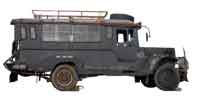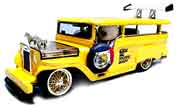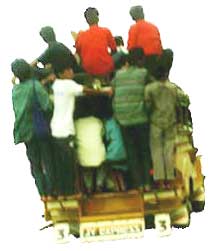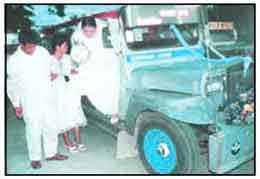by Godofredo U. Stuart Jr. |
Also read: Requiem for the King? |
|
Surely, it has come a long way from being the World War ll Willys jeep surplus that provided an early postwar topless form of share-taxi transportation, soon enough acquiring a roof and stretching the back to accommodate more passengers, taking on colors and accessories. Even as the supply of Willy jeeps and alternative mother-vehicles became exhausted, it continued to spawn an industry and commerce of build-from-scratch jeepney production, providing the needs of the populace for an affordable means of transportation and all imaginable hauling needs. It was, indeed, the workhorse of Philippine transportation, and deservedly for decades, it was the "Undisputed King of the Road." To say that it continues
to be the symbol of the Filipino's creativity, innovativeness and
ingenuity is arguable. The jeepney has remained in its angular and
boxy construction, gas-guzzling and weighty with its In an age of incredible automotive innovations for fuel efficiency, aerodynamics, safety and creature comforts, the jeepney has remained an immutable, uncomfortable, gas-guzzling and polluting anachronism, severely lacking in safety features and unadaptable to universal safety and seat-belt regulations. Its boxed interior is designed to cram up as many passengers as possible. Check out the spare tire, easily inspected on the driver-side, and the threads are usually so worn out, dental floss in the groove would stick out. Some are a thumb-tack away from a blown-tire. It's the nature of this surplus- and recycled parts-laden metal beast on wheels. Ubiquitous in the pages of travel brochures, the jeepney is often blazoned as an "essential part of the Philippine adventure" . . . Um. . . well, sort of. . . in a Third-World-cheap-thrills kind of way. A Can of Sardines
But, it is the transportation mode for the 'masa,' the proletariat, the working class. It's Third-World transpo. The burgis would not be caught riding one.

A work of Art
on Wheels?
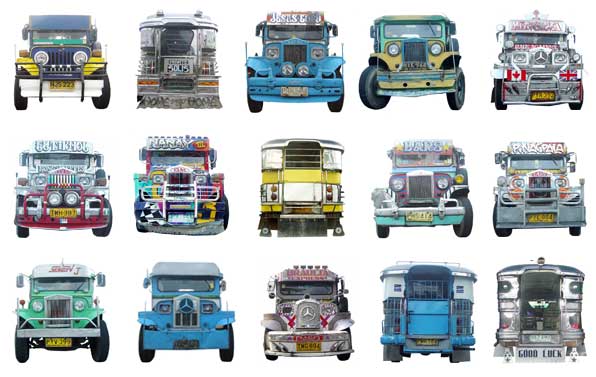
But there are head-turners—jeepneys that qualify as "art-on-wheels," although few and far in-between — show-case jeepneys made especially for tours, fairs and exhibits and privately owned jeepneys, malignant with art and accessories, veritable works of art, glistening in their shining armor of steel, their hoods crowded with protrusions of accessories, the sides an expanse of metal canvas colorfully filled with sticker or airbrushed art. Of these few, most are owned by those with deep pockets; a few, perhaps, who have found in their rolling canvas of steel an outlet for their creative expression; and some, by those who save or readily put out their last pesos to upgrade or add a borloloy here and there. . . .taking pride, or doing it . . . just because.

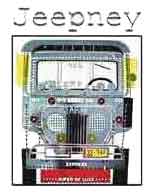 Jeepney
art is a combination of the "art of the accessory" and the
"art of the color" applied on a basic canvas shell of galvanized
metal or buffed and glimmering stainless steel. Accessories are, for
the most part, decided or handpicked, altered or added on at the owner's
whim. The "art of the color" is usually applied by airbrush
or sticker artists. Many jeepneys concentrate the art on the front, insanely cramming the hood area with accessories, the sides with empty galvanized expanses or scatterings of ads and small art. Some are gleamingly and colorfully wrapped with accessories and airbrushed or stickered art. Jeepney
art is a combination of the "art of the accessory" and the
"art of the color" applied on a basic canvas shell of galvanized
metal or buffed and glimmering stainless steel. Accessories are, for
the most part, decided or handpicked, altered or added on at the owner's
whim. The "art of the color" is usually applied by airbrush
or sticker artists. Many jeepneys concentrate the art on the front, insanely cramming the hood area with accessories, the sides with empty galvanized expanses or scatterings of ads and small art. Some are gleamingly and colorfully wrapped with accessories and airbrushed or stickered art.
No two jeepneys are alike. Even the drab generics show distinct differences. Customizing starts with the shell, a detail here and a detail there. Then the myriad of personal touches - a choice accessory, horses and horns, lights and mirrors, flaps and guards, names and dedications, a color preference, an art theme, a religious icon or invocation - a composite of details that proudly blazons a signature, a personal statement and ownership.
The
art of the color
It is a rare jeepney that does not use color - that rare specimen of pure gleaming stainless steel nakedness or dreadfully barren galvanized shell. Color dresses up the metal shell. The front, usually so crammed and crowded with accessories, take on simple accenting and decorating stripes of color on the hoods and fenders. Some jeepneys cram the all the accessories and art in front, leaving the side bare and barren, typical of many jeepneys plying the San Pablo-Tiaong-Candelaria route. For many jeepneys, the "visual art" extends to the sides, long expanses of metal for more proletarian doodling of sticker-art collage. And sometimes, the art and the color extends all the way to the back. (See: Jeepney 88 and Jeepney 87) 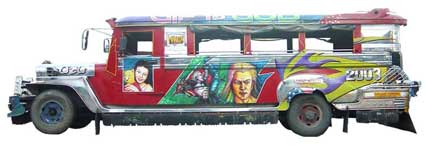 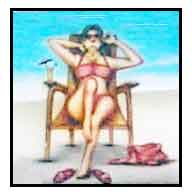 The
art is usually the handiwork of jeepney artists. Although there
are set-designs, the prospective owners may request certain themes
or the addition of religious
images or favorite quotes that are easily accommodated into
the vast canvas of its metal shell. Most of the art is done through
the use of colored plastic stickers, available in 6" wide rolls,
costing P35 per foot, an average jeepney using between 150 to 220
feet, painstakingly and economically cut into design and seamlessly
applied to the outside metal work, the labor cost ranging from P2,500
to P3,500. With the limitations of sticker art and colors, some
prefer the use of airbrush painting allowing an expanded thematic
spectrum – 'heavy metal' and fantasy-type art –and tonal
values unachievable with sticker art . Not uncommonly, the side-art
accommodates an incongruity of themes, an image of Christ juxtaposed
with fighter planes, religious icons jostling for space with heavy
metal images, a Disney character or NBA team logo or a sundry of
things American for any leftover space big enough to accommodate
it. The
art is usually the handiwork of jeepney artists. Although there
are set-designs, the prospective owners may request certain themes
or the addition of religious
images or favorite quotes that are easily accommodated into
the vast canvas of its metal shell. Most of the art is done through
the use of colored plastic stickers, available in 6" wide rolls,
costing P35 per foot, an average jeepney using between 150 to 220
feet, painstakingly and economically cut into design and seamlessly
applied to the outside metal work, the labor cost ranging from P2,500
to P3,500. With the limitations of sticker art and colors, some
prefer the use of airbrush painting allowing an expanded thematic
spectrum – 'heavy metal' and fantasy-type art –and tonal
values unachievable with sticker art . Not uncommonly, the side-art
accommodates an incongruity of themes, an image of Christ juxtaposed
with fighter planes, religious icons jostling for space with heavy
metal images, a Disney character or NBA team logo or a sundry of
things American for any leftover space big enough to accommodate
it. In jeepney art, anything goes. Some are "passive" artworks, compositions of jeepney artists commissioned by the manufacturers, remaining unchanged in its original form, except for the personal touch of a doodad here or a name there. Some are kinetic, frenetic, constantly mutating works by owners – frustrated artists or rabid incarnate of artists long-dead – unendingly adding and slapping details of colors and accessories. And they are out there, alas, buried in ubiquity. But seek and you shall find – rare pieces of metal works, strutting design and screaming attitude. They deserve a smile, a nod, or a thumbs-up. 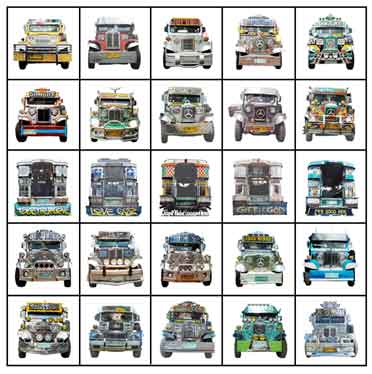 It
is art. . . Rococo. Baroque. Pop. Dada. Mobile art. Construction art.
Collage-on-wheels. Art-on-wheels. Graffiti-on-wheels. Folk art. Pinoy
art. People's art. Proletarian Art. Masa Art. It
is art. . . Rococo. Baroque. Pop. Dada. Mobile art. Construction art.
Collage-on-wheels. Art-on-wheels. Graffiti-on-wheels. Folk art. Pinoy
art. People's art. Proletarian Art. Masa Art.In a country devoid of any populist program of art, where art is an indulgence of the literati and bourgeoisie, jeepney art is probably the sole venue for expression of true proletarian art.
Styles and sizes. Styles vary regionally. The use of "borloloys" (accessories) are typical in the urban-suburban areas and most provinces. There are cycles and regional preferences for certain accessories, colors and sticker art. In some regions , horses and mirrors might dominate the hood space; in others, lights and antennae. Jeepney-gazers can spot and identify details of color, art and style and say: That's a mid-80s Amante! . . or. . . That's an Armac! The jeepneys in the Biñan-Calamba area are stylistically spartan with a minimum of sticker art and accessories, and a distinctly different roof style constructed with padded canvas, The Baguio jeepneys sit higher up off the ground, almost all with roof -racks for top-load hauling and the spare-tire, weather-proofed with double back doors and sliding windows, and an outside art showing showing an affinity for American places and icons, cowboys and indians, NBA logos, and their signature wide-stripes of colors.
The inside has not changed much in the past decades — relatively barren compared to the frenzy of colors and accessories on the outside. The back's length dimension may be custom-stretched to accommodate as much as 28 passengers, 14 abreast. On average, passenger jeepneys sit 16 to 20 in the back, on padded bench-type seats; 2 passengers in front, plus the driver. There are ceiling hand-rails to hold on to. Roll-down window shades for rainy days or a touch of frau-frau with frilly crocheted sliding curtains.
The dashboard area is the driver's personal space, filled with personal knickknacks, controls for ear-splitting stereo sounds when deep pockets allow, and not uncommonly, a space for religious icons and occasional elaborate miniature altars. Billboard
on Wheels

King
of the road. . . not.
The "Family Jeepney" has been largely replaced by surplus vans from Japan, more economical in gas consumption, air-conditioned to boot, a step-up in the ladder of consumer status. Hauling alternatives are now provided by medium-sized Elfs and bigger for-hire vehicles. In the urban settings, its share of passengers has been decimated by affordable air-conditioned share-taxis or vans. Many feel the jeepney has been bullied by edicts banning them from major passenger routes, Add to that: government imposed rates, licensing, the rising cost of fuel prices and maintenance, and the increasing difficulty in meeting and existing on the "boundary" arrangements between jeepney owner and contracted driver, the latter taking home a third of the collected fare. In some provinces, it thrives. In Baguio, where there is a ban on tricycles, the jeepneys continue to reign supreme. •
by
Godofredo Umali Stuart
|
 |
|||
Also read: Requiem for the King? |
|||
All Jeepney
images are copyright © Godofredo Stuart / StuartXchange |
|||

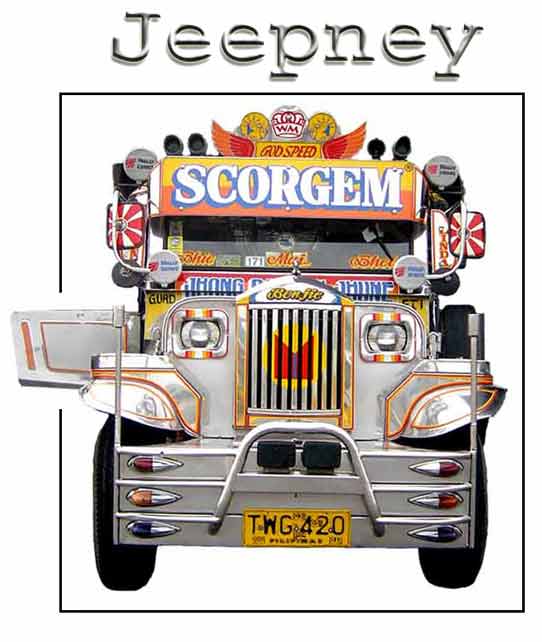 The Jeepney was once called the "Undisputed
King of the Road". . .
The Jeepney was once called the "Undisputed
King of the Road". . . 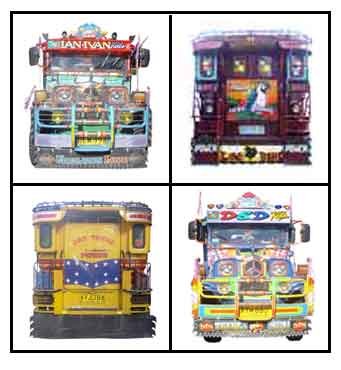 20
plus sheets of 15- to 18-gauge stainless steel or galvanized sheets,
its guts usually surplus Japanese diesel engines and chassis, its
aerodynamics eaten up by an unyielding metal shell and its profusion
of accessories, mirrors, grills and guards.
20
plus sheets of 15- to 18-gauge stainless steel or galvanized sheets,
its guts usually surplus Japanese diesel engines and chassis, its
aerodynamics eaten up by an unyielding metal shell and its profusion
of accessories, mirrors, grills and guards.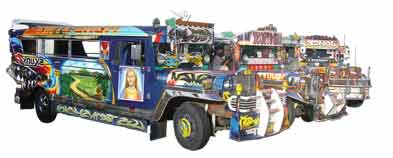
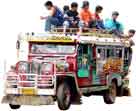
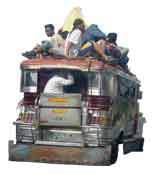
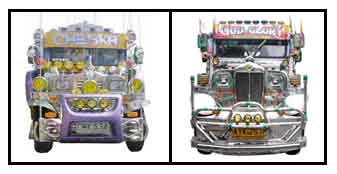 The
art of the borloloys
The
art of the borloloys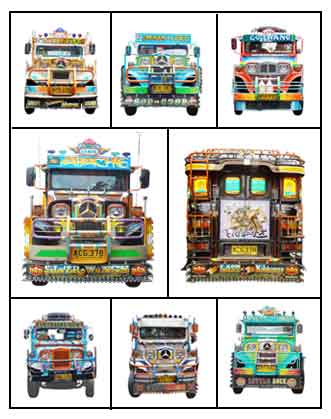

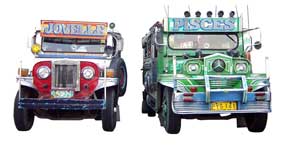
 Short
routes and small-load needs have been supplanted by the pesky tricycle
(Trik), nimble and superior it its maneuverability, able to U-turn
on a dime. Perhaps, as some observers have posited, Trik can claim
the title of the new "King of the Road." Many say: King
Pest of the Road.
Short
routes and small-load needs have been supplanted by the pesky tricycle
(Trik), nimble and superior it its maneuverability, able to U-turn
on a dime. Perhaps, as some observers have posited, Trik can claim
the title of the new "King of the Road." Many say: King
Pest of the Road.